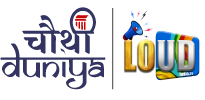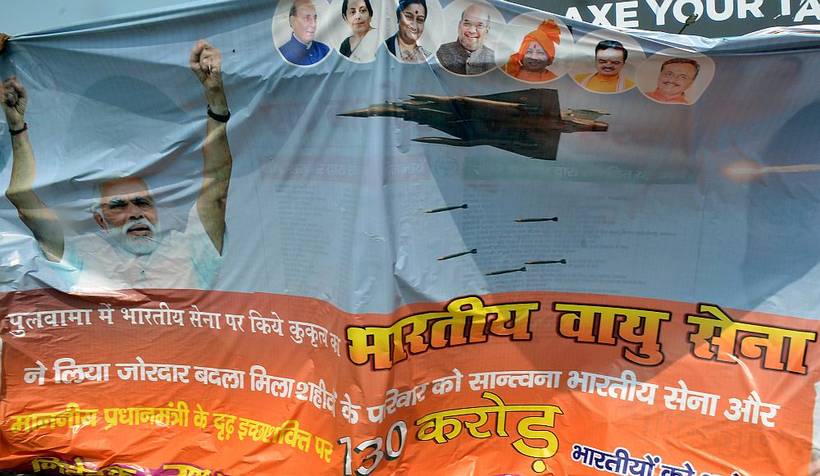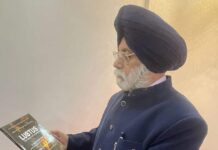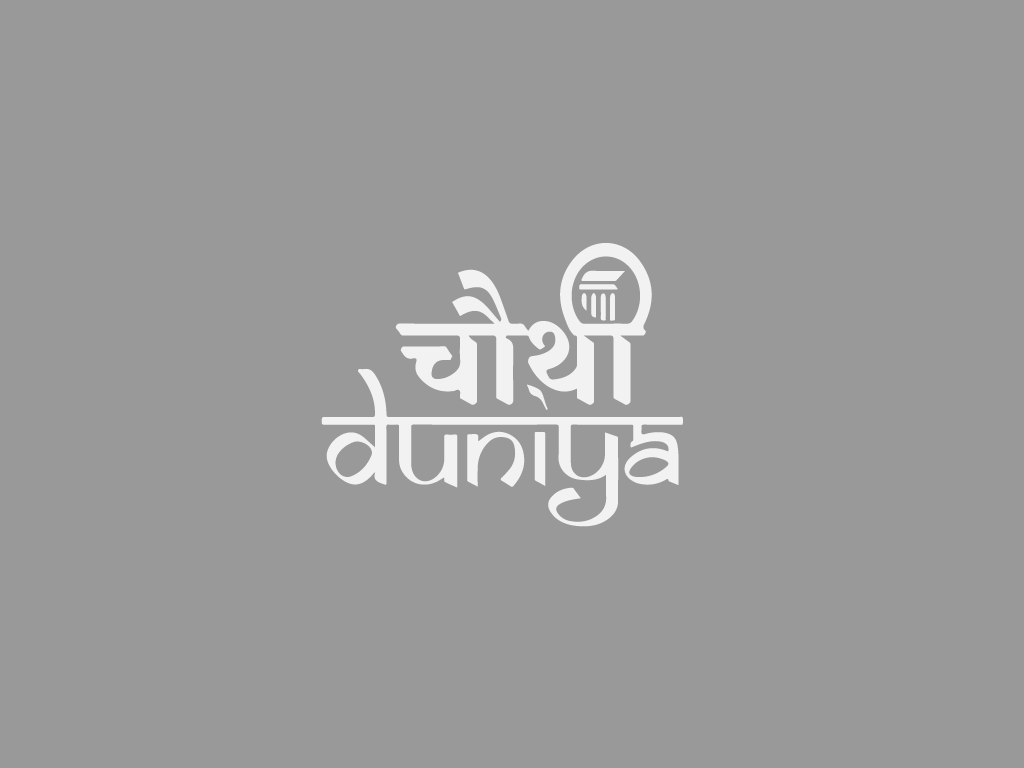India’s dyed-in-the wool ‘nationalist’ TV channels have made it clear that even as they rage
against Pakistan, they will also hunt down anyone defying the agenda to counsel peace
between India and Pakistan. Vidya Subrahmaniam, Senior Fellow, The Hindu Centre for
Politics and Public Policy, New Delhi, captures the frenzy that overtook the TV media in the
wake of the Pulwama attack and warns of the dangers inherent in allowing a free run to the
stirred up faux nationalism that has already turned journalist against journalist.
A lot has been written about the daily battle scenes enacted in Indian
television studios by flag-waving nationalist anchors, some of them
clothed in combat fatigues just in case viewers mistook the stomping of
feet and waving of hands for a dance show. Following the killing of 40 jawans in a terrorist attack on a Central Reserve Police Force (CRPF) convoy in the Kashmir valley, TV voices had grown shriller and shriller. The call for action was not just against terrorists operating from Pakistan’s soil, but also for taking out Pakistan, to erase it off the map. From Republic TV and Times Now to the full range of Hindi news channels, the studios had been turned
into war rooms to cries of Pakistan ko mita denge (we will wipe out Pakistan).
No journalist worth her salt could be unfamiliar with the Prime Time drill, as the
hazards of surfing the news channels came with the territory. The staple consisted
of anchors getting enraged over something or the other that required the Opposition
and liberal citizens to be pummelled, even if, or especially if, it was the government
that had been up to no good. While viewing this feigned anger was tedious,
occasionally it was possible to see the funny side of it. For Times Now, the liberal
sections were a “Lobby” to whom several hashtags were dedicated, such as
#WhereIsTheLobby?; #LobbyExposed; #LobbyHiding; #LobbyShamed and so
forth. On a normal day, the resident army general who screamed his lungs out at allbut the incumbent government, was also good for a few laughs.
But the blood and gore spectacle that unfolded on TV over the days after Pulwama
was more scary than funny. All the forewarnings I had from fellow journalists who
had watched it and written about it – including columnists Kalpana Sharma and Salil
Tripathi1
2 – didn’t prepare me for the sight of the relentless bloodhound that
occupied the newsroom, presumably as an aggressive mascot of Prime Minister
Narendra Modi’s New India. As I recorded what I saw, my senses reeled and I began
to feel fearful – for all those who had taken on the Modi regime and even more for
the country which appeared inexorably to be crossing over to the dark side. The
raging against Pakistan seemed to go hand in hand with a magnificent self-delusion
about India as a Superpower that had brought Pakistan to its knees, and without the
intervention of other nations.
With the captured pilot, Abhinandan Varthaman, still in Pakistan’s custody, the
channels socked it to Prime Minister Imran Khan, painting him as a weakling who
had surrendered to the might of India. Indian TV commentariat bristled at the
suggestion that international intervention might have got Pakistan to order his
release, saying in one voice that ‘New India’ had achieved this ‘enormous feat’ on
its own. All this even as public as well as political opinion in Pakistan seemed by a
wide margin to favour the immediate return of the captured pilot. Pakistan’s
Parliament had unanimously welcomed Imran Khan’s announcement that
Abhinandan would be very shortly released.
On the day of Abhinandan’s release, in fact with just hours left for it, and a lastminute hitch not ruled out, the gloating hit a peak. Senior NewsX anchor Rishabh Gulati said Abhinandan was returning home because India had transformed from a wimpy also-ran to a great power. “And that great power has for the first time shrugged off the shackled mindset that in the past had led it to thousands of years of ghulami (slavery).” Indeed, India did not “fiddle and fiddle”, as in the past, but had ordered Pakistan to “return the pilot or else!” Gulati, who seemed to suggest that India’s rise to glory from nowhere was all due to “one man” (no prizes for guessing who), then turned to his reporter waiting at the Wagah border and asked,
“How’s the Josh?” (How’s the energy?)” This line from the film, Uri, an unabashed
ode to the surgical strike that followed the terror attack on the Uri army base, has in
recent days become the BJP’s favoured greeting.Meanwhile, Times Now was sprouting colourful hashtags and teasers, among them:
#IndiaCutsNayaPakistantoSize and ‘Spooked by India’s offensive, Imran’s Mantri
Runs For Cover’, and of course, a reminder to the viewers that #BharatBadalGayaHai. The
two young anchors in the studio agreed with each other that Pakistan did not matter because the world did not want to give it any importance. There was also plenty of poetry for the Prisoner of War. A panellist on a later show on the channel would thus extol
Abhinandan: “I can see Shivaji in him, I can see Maharana Pratap in him, I can see
Guru Gobind Singh in him. He is the summation of civilisation. He is the summation
of Indian culture. He is the summation of Indian history.”
As the evening wore on, there was no sign of Abhinandan. There was a hitch
apparently, and while this was reason for the anchors to outrage some more, there
was just a hint of a suggestion from the Pakistan end that the cause of the trouble
could in fact be Indian TV. Islamabad-based anchor for 92 News, Amir Mateen,
tweeted: “Parliamentarians not happy with Indian media giving wrong twist that
Pakistan buckled under Indian threat/pressure. Many already suggest that we should
reconsider … Let’s not spoil a decent move.”
In the end, the “decent move” was spoilt. Pakistani authorities forced Abhinandan to
record a video where he praised the Pakistan army and slammed the Indian media.
Watching the video, it was difficult not to conclude that the Wing Commander was
being used as a proxy. The lines he spoke or was made to speak, “Bharatiya media
itna mirch lagake, aag lagake bolte hain,” (the India media adds unnecessary fire
and chilli to its words) were likely the lines that Pakistan itself wanted to say about
the Indian media But the video and what it implied did not cause TV to rethink its strategy, much less accept that its hectoring and jingoism had placed Abhinandan and his family in
danger. If Pakistan, as the anchors ad nauseam informed us, was a rogue state, then
wasn’t it important for the media not to push it to the brink? At the minimum while
the ‘enemy’ held the Indian pilot hostage, which fact also endangered his family? No. Instead the TV channels furiously turned on liberal opinion-makers, among them their own in the profession.
The liberal as the ‘other’ The reason for this was that soon following Imran Khan’s offer to release Abhinandan, sections of Indian liberal media had welcomed the gesture, seeing it as a sign of maturity in a leader who had also spoken of suing for peace with
India. Khan had said that as nuclear neighbours, India and Pakistan had to rein in
their hostilities: “All wars are miscalculated. And no one knows where they lead to
… I ask with the weapons you have and the weapons we have, can we really afford
a miscalculation?… Let’s sit together and settle this with talks.” A number of Indian
journalists tweeted their support to Khan, including Sagarika Ghose: “Excellent,
statesmanlike speech from @ImranKhanPTI” Predictably, she was set upon by trolls
excoriating her in words that cannot be reproduced here. For an idea, among the least
offensive things said to her was that her account, as well as her mind and heart, had
probably been hacked by Pakistan.
The lynch mob calls ricocheted off the TV echo chambers. At Republic TV there
was a deceptive air of calm in the minutes before Abhinandan’s release Editor-inChief Arnab Goswami told his panellists the special moment had to be savoured.
“Everything else can wait,” he said, adding with a hint of menace, “We will surely
discuss other things. But in a minute.” Soon enough the gloves were off. “Let it sink
in that this is just a trial run. The real revenge begins now,” Goswami said. A veteran
of many real and TV studio wars, General G.D. Bakshi, chipped in. “There is no
question of backing off now. No question of taking our feet off the pedal.”
Pakistan’s fate settled, Goswami and General Bakshi, a pair that has hunted down
many liberals and ‘urban naxals’, turned on their all-time favourite target. “We will
finish off Pakistan. But what do we do with the peaceniks and Pak premi patrakars?
(Pak-loving journalists).” Bakshi asked. “De-escalation, de-escalation, deescalation,” Goswami thundered. A lengthy declamation against the “de-escalation
champions’, “the gaddars (traitors)” who feted and garlanded Pakistani terrorists
later, the duo decided they would be befittingly punished by the people of India:
“Like bloody hell, they will do it.”
But the worst was still to come, and it came in the form of a programme, Bindas Bol,
on Sudarshan News. According to Wikipedia, Sudarshan News is a Hindutva
channel operating out of Noida in Uttar Pradesh. Bindas Bol is hosted by Suresh
Chavhanke, who is Chairman, Managing Editor and Editor-in-Chief of the channel.
Chavhanke’s Wiki page has this to say about him: “Suresh Chavhanke claims to be
a member of the Rashtriya Swayam Sevak Sangh [(RSS)] since the age of three years
when he started attending its ceremonies. As a member of RSS, he had worked as a
reporter of pro-RSS newspaper, Tarun Bharat. He held several posts in the RSS
before becoming a full time reporter.” The website of Bindas Bol proclaims in a
splashy banner heading, ‘Khoon ka badle khoon’ (Blood for blood).
The day after Abhinandan’s return, Bindas Bol hosted a “world exclusive”, whose
aim, to quote Chavhanke, was to “expose and shame the Pak premi
Patrakars”. Chavhanke explained that he had chosen a unique format for this
disrobing exercise which was to invite nationalist journalists to condemn the
‘traitors’ among their own lot. The list of ‘traitors’ was unsurprisingly headed by
NDTV India’s Ravish Kumar, and he was followed by the usual suspects: Nidhi
Razdan, Sagarika Ghose, Rajdeep Sardesai, Barkha Dutt, Rana Ayub, and so forth.
A surprise inclusion in the list was The Hindu newspaper, recognised internationally
for being sober and reliable.
The nationalist panel, that had been invited to shame them, had another set of
journalists: Mayank Jain, Sumanth Bhattacharya, Umesh Chaturvedi and Rakesh
Arya, all described only as ‘senior journalists’. Chavhanke invited them by turn,
interspersing their harangues with phoned- in calls from regular viewers of the
channel. The nationalist journalists and the callers were shown videos and tweets of
the traitors so they could be suitably enraged.
Passing off rant as opinion
The video clip of Ravish Kumar showed him regretting that India had not thanked
Imran Khan for unconditionally releasing Abhinandan. Kumar also wanted thanks
extended to those who were opposed to a war between Pakistan and India. This was
too much for Mayank Jain: “NDTV is Pakistan’s own channel. Do you know that
some of the editorials in our newspapers are written by Pakistan? These journalists
work for the ISI, and hence their praise of Imran Khan.” Jain was convinced a lot
of the liberal mischief was because Modi was getting popular: “Mark my words. The
coming election is going to be fought between Narendra Modi and Imran Khan.”
Journalist Sumanth Bhattacharya said that for far too long, journalists had put out
one-sided version of events without anyone questioning them. In his view, the
advent of Social Media had altered this equation, but sadly the challengers were
being slandered as trolls: “Who are the trolls? These are ordinary people who have
found their voice and will robustly challenge the entrenched media and their
biased stories.”
At this point host Chavhanke intervened. He said he was very angry with The
Hindu for an allegedly misleading headline in the February 28, 2019, edition of the
newspaper. The headline, “IAF plane shot down, pilot taken captive by Pak. Army”,
was “wrong”, he said, because “it contradicted the official version that the plane had
fallen on its own due to a technical fault”. From among newspapers, why The
Hindu was singled out for shaming when its reporting had been factual and accurate
was unclear. As a matter of fact, all others papers had said the jet was shot down. The
Indian Express of the same date said: “The day that began with Pakistan Air Force
shooting down a MIG fighter jet and an Indian Air Force pilot being captured by
Pakistan’s army …”Journalist Umesh Chaturvedi was of the opinion that the traitors in the list had taken up for Pakistan because the Modi Government had not rewarded them:
“These people are a curse on this nation. You have to be a nationalist before
being a journalist. I want all journalists to stand together as nationalists without
a distinction.”
Of the many phone-in callers who joined the denunciation rite, one was particularly
unforgiving. He said aside from being a “gaddar”, Ravish Kumar was also a
supporter of Muslims. The time had come therefore for the nationalists to go from
door to door and thrash the traitors with “joote-chappal”. Chavhanke, beamed at this.
He didn’t believe in violence, he said, but if the “gaddars insisted on spreading
poison by praising the enemy country,” they had to be prepared for “joote-chappal”.
Journalist Rakesh Arya offered a solution that would once and for all end the menace
of gaddari. He said the government should define Rashtrawad(nationalism) and
then go on to enact a law that would treat any breach of the definition as treason. “In
gaddaron ko kathor se kathor dandh milna chahiye” (these traitors should get the
worst possible punishment).
Chavhanke’s claim to fame before this was his arrest on April 13, 2017, for fanning
communal tensions in U.P. Chavhanke’s ‘defence’ at the time was that he had been
arrested by an administration that was loyal to Akhilesh Yadav, even though Yadav
had been replaced by the BJP’s Yogi Adityanath at the head of a new government.
On a surface level, all of the above can be treated as non-serious, as the work of a
loony fringe, or even as theatrical entertainment.
Indeed there is a spoofy, stand-up comic look to much of the war pantomime acted out in the studios. Yet the comic-commando act, to borrow a lovely phrase from journalist Shekhar Gupta, is capable of causing lasting harm. A part-communal, part-pseudo-nationalist poison has seeped deep into India’s collective thinking. There is no guarantee that today’s verbal calls to extinguish liberal dissent will not turn tomorrow into physical attacks on liberal sections.
We have a Prime Minister with words full of violence. “Chun chun ke maarna meri fitrat
hai” ( I’m given to picking my targets one by one and finishing them), he said, at a
recent rally, making it clear that the warning applied as much to Pakistan as to Indian
citizens inclined to question the government on its national security moves. We have
a rah-rah ‘nationalist’ media that has taken it upon itself to shame, punish and deter
the ‘deviants’ among its own community. When the two – government and media –
The comic-commando act is capable of causing lasting harm. feed off each other, as is happening now, the result is a lynch mob that operates with official sanction. The threat to Indian democracy is very real. [This is the first of a two-part essay on the Indian media. The second will examine how the media treated earlier regimes, starting with the government of Rajiv Gandhi.]
Vidya Subrahmaniam
















